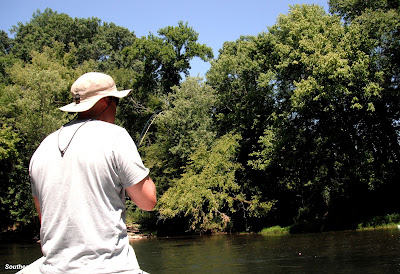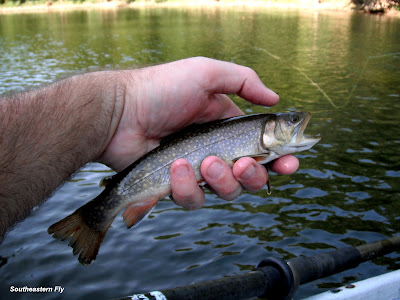 |
| Catch'em & Throw'em Back... |
Don't let the title fool ya, we will get to the fishing report in a bit. Here is part of a discussion that Brent and I had several months back and it was wrapped around a question. Do fish always look down toward the water when they are out of the water? It has probably been pondered, discussed and debated by others on many different occasions. Some of those discussions, ponderings and debates, I may or may not have been privy to and if I was, I may or may not have remembered. But Brent brought it up and I remember at least part of the conversation, so lets just go with that for now. I went back and looked at several photos and most of the photos show the fish apparently deciding their next move and how a quick wiggle is going to get them back in the water from where they came.
**
Before this gets a whole other discussion going about the ethical treatment of fish, it is best to let the fish sit, in the net after the fight, while the net is in the water. That gives the fish time to get its breath back and to do all those scientific things that fish do while they are reviving themselves. Use that time to get the camera ready and if needed to give the angler time to stop shaking. So, I guess I am saying we treat the fish as best we can and if you are getting a photo, we hope you treat them as best you can. We hope so because, we want to catch it again, especially if it is a big one. That's a long way around the barn to figure out whether or not a fish always looks down toward the water when it is out of the water. Come to think of it there is probably a government grant to figure all this out...we, however are doing it for free.
 |
| The Usual Suspects |
Caney Fork River- A lot has been said about the Caney Fork. There are a whole bunch of canoes on the water, especially on the weekends and especially on the upper float. So, try to fish before the rental companies begin to release the canoes or after they release the last batch of the day. Anyone who has spent any time on the Caney knows that the people at the rental companies like to go home at night and they stop releasing canoes sometime after 3:00 p.m. (or there about). You can fish the evening hatch on most weekdays and if it is threatening rain and terrible weather, well even better. The fish are still eating, however not in the middle of 50 screaming kids beating their paddles in on the side of an aluminum canoe. That sound tends to send fish into the bottom of the holes and tends to send anglers to therapy. Anglers who fish the upper section need to decide whether it is worth the heartache before leaving the house.
 |
| An Unusual Suspect |
There are still some good fish in the Caney. The hatches are quite interesting. Everything from the usual midge hatches, to caddis and even some of those softer bodied mayflies, which are easier to eat and apparently better tasting, if you get my drift. So branch out and try some different stuff. Nymphs are still the way to go, if you are going for numbers. We fished some terrestrials recently with no luck, but I remain optimistic, especially when a trout ate an indicator. With any luck hoppers will start falling in the river soon and that bite will be on. Streamers are still working, but there is a point that a streamer is actually too large, which we found this week. Dang that was tough to say, but it is true. White and yellow are the colors of choice. If the water gets stained then go darker and work to the other end of the color chart. And here is something else to consider. Find a pattern that you are comfortable fishing and just change colors and size as needed. Fishing the same pattern seems counter-productive, but it can teach line and fly control.
 |
| Phishtails |
The US Army Corps has decided to release water from 3:00 a.m. to 5:00 a.m. That is cooling the Cumberland River downstream at the power plant at about the right time and as a byproduct the trout in the Caney Fork get to cool off too. The water temps we took on the last float were 58 degrees. Some folks have asked how we generally take the reading. Usually I will drop a thermometer over the side of the boat, on 3' piece of tippet, for about 3 or 4 minutes and then see what it says. Highly scientific and sometimes accurate. The last reading, however, was a bit different. I dropped the thermometer over the side of the boat, then began rigging rods. We pushed off from the gravel bar and began the float. Naturally we started searching for fish and watching flies. About 45 minutes into the float and after passing over several gravel bars a line got tangled. When the line was pulled up there was a thermometer on a piece of tippet that looked just like mine and it read 58 degrees. As I said highly scientific. There it is, a "different" look into the Caney Fork and hopefully a tip or two that will with someone's angling.



































